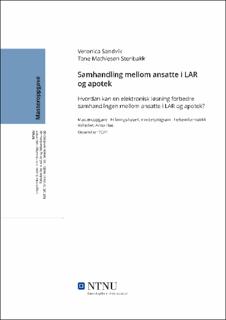| dc.contributor.advisor | Das, Anita | |
| dc.contributor.author | Sandvik, Veronica | |
| dc.contributor.author | Stenbakk, Tone Mathiesen | |
| dc.date.accessioned | 2022-03-01T18:19:23Z | |
| dc.date.available | 2022-03-01T18:19:23Z | |
| dc.date.issued | 2021 | |
| dc.identifier | no.ntnu:inspera:88774930:37926723 | |
| dc.identifier.uri | https://hdl.handle.net/11250/2982217 | |
| dc.description.abstract | En stor andel LAR-pasienter får utlevert legemiddeldoser i apotek. Hensikten med denne studien er å finne ut hvordan samhandlingen foregår og oppleves for ansatte i LAR og apotek, og på bakgrunn av opplevde utfordringer, behov og krav, se om det er mulig å lage et konsept på en elektronisk løsning.
Vi valgte kvalitativ metode for datainnsamlingen og tok i bruk fokuserte intervjuer, åpent, faktuelt intervju og workshop. Som tilnærming valgte vi tjenestedesign, og for å visualisere arbeidsprosessene har vi brukt modelleringsspråket Business Process Model and Notation.
Det er lege i LAR som har behandlingsansvaret for pasientene, og som bestemmer type legemiddel, dosering og hvordan dosen skal gis. Ansatte i apotek trenger resept og informasjon om henteordningen for å kunne gi pasientene riktig oppfølging. Gjennom intervjuene kom det fram at aktørene har behov for å samhandle ved oppstart og endringer på henteordningen. Noen gir informasjon muntlig via telefon eller bruker kommentarfeltet i e-resept, men de fleste bruker et dokument. Dokumentet har ulike navn og ulikt innhold, selv om det finnes en mal. Da det ikke finnes en tilrettelagt elektronisk løsning for samhandlingen, har de tatt i bruk telefon, e-post, faks og posten for informasjonsdelingen. I tillegg til informasjon om henteordningen har de behov for å dele informasjon om avvik ved henting, generelle beskjeder og bekymringer rundt pasientens situasjon.
Samhandlingen blir oppfattet som god, og så optimal som mulig med de verktøyene de har i dag. En av grunnene til at samhandlingen fungerer, er at de kjenner hverandre etter å ha samarbeidet over tid. Funnene viser at de savner en mer effektiv og sikker måte å sende informasjonen på, da postgangen tar tid og personvernet ikke blir ivaretatt ved de andre løsningene.
Vi har identifisert tre hovedutfordringer, som vi har valgt å basere konseptet på. Konseptet består av en elektronisk løsning for sending av henteordningen, digital dialog for kommunikasjon og varsling om utgåtte resepter. Flere av informantene trekker frem at en elektronisk løsning ikke kan erstatte telefonen, men at den kan være et supplement.
Å innføre en elektronisk løsning kan gi flere gevinster for samhandling. Aktørene mener at det vil spare tid og senker terskelen for kommunikasjon. Kommunikasjonen blir dokumentert og personvernet blir ivaretatt. I tillegg vil det bidra til en raskere, enklere, smidigere og mer effektiv samhandling.
| |
| dc.description.abstract | Many patients on opioid substituted treatments (OST) receive drug doses in pharmacies. The purpose of this study is to find out how people interact and how the employees in OST and pharmacies experienced this interaction. Based on the challenges people experienced, we want to see if it is possible to create a concept for an electronic solution, based on the needs and requirements from the participants.
We chose a qualitative method and used focused interviews, open, factual interviews and workshops for data collection. As an approach we chose service design, and to visualize the business processes we have used the modeling language Business Process Model and Notation.
Doctors in OST are responsible for the patient's treatment, and they decide the type of medicine, dosage and how the dose should be given. Employees in pharmacies need a prescription and information about the dispensing of medicines to be able to give patients the correct follow-up. Through the interviews, it became clear that the participants need to interact at the start of the agreement and when there are changes to the dispensing of medicines. Some give information orally by telephone or use the comment field in e-prescriptions. Most people use a document for information. The document has different names and different contents, although there is a template available. As there is no adapted electronic solution for the interactions between doctors and pharmacies, they have used the telephone, e-mail, fax and mail for sharing information. In addition to information about the dispending of medicines, they need to share information about deviations during dispensing, general messages and concerns about the patient's situation.
The interaction is perceived as good, and as optimal as possible with the tools available today. One of the reasons why interacting this way works is that the employees know each other after working together over time. The findings show that they lack a more efficient and secure way to send information, as the post takes time and privacy is not taken care of by the other solutions.
We have identified three main challenges, which we have chosen to base the concept on. The concept consists of an electronic solution for sending information about dispensing of medicines, digital dialogue for communication and notification of expired prescriptions. Several of the participants pointed out that an electronic solution cannot replace the telephone, but that it can be used to supplement it.
Introducing an electronic solution can provide several benefits for collaboration. The participants believe that it will save time and lower the threshold for communication. It would provide documentation and would safeguard privacy. In addition, it will contribute to faster, easier, smoother and more efficient interactions. | |
| dc.language | nob | |
| dc.publisher | NTNU | |
| dc.title | Samhandling mellom ansatte i LAR og apotek | |
| dc.type | Master thesis | |
